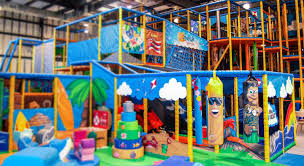
Soft Play Wonderland: A World of Fun and Learning for Kids
The Joy of Soft Play: A World of Fun and Learning
Soft play areas have become a staple in the world of children’s entertainment, offering a safe and engaging environment for kids to explore, learn, and have fun. These colourful and interactive spaces are designed to stimulate children’s senses, encourage physical activity, and spark their imagination.
One of the key benefits of soft play is the emphasis on safety. With padded floors, cushioned obstacles, and soft toys, children can freely move around without the risk of injury. This gives parents peace of mind knowing that their little ones can play to their heart’s content in a secure setting.
Moreover, soft play areas provide an excellent opportunity for children to develop their motor skills and coordination. Climbing structures, tunnels, slides, and ball pits offer a range of physical challenges that help kids build strength, balance, and agility in a fun and engaging way.
But soft play is not just about physical activity; it also nurtures social skills and creativity. Children have the chance to interact with others, share toys, take turns, and collaborate on imaginative games. These experiences help them develop communication skills, empathy, teamwork, and problem-solving abilities.
Soft play areas often feature themed zones that transport children to different worlds – from jungle adventures to underwater realms – sparking their curiosity and encouraging pretend play. Whether they’re role-playing as pirates on a ship or exploring a magical castle, children’s imaginations are free to roam in these immersive settings.
In conclusion, soft play is more than just a fun pastime for kids; it’s a valuable learning experience that promotes physical development, social interaction, creativity, and cognitive skills. So next time you visit a soft play centre with your child, watch as they explore this exciting world of wonder and discovery!
9 Benefits of Soft Play: Safe, Fun, and Developmental Spaces for Children
- Safe environment for children to play and explore.
- Padded floors and cushioned obstacles reduce the risk of injuries.
- Promotes physical activity and helps develop motor skills.
- Encourages social interaction and teamwork among children.
- Fosters creativity through imaginative play in themed zones.
- Provides a fun and engaging way for kids to learn and grow.
- Offers a variety of activities that cater to different interests and abilities.
- Allows children to express themselves freely in a supportive setting.
- Creates lasting memories for families through shared experiences.
7 Drawbacks of Soft Play Areas: From Crowds to Costs
- Soft play areas can get crowded, leading to long wait times for popular attractions.
- The noise level in soft play centres can be overwhelming, especially during peak hours.
- Children may sometimes exhibit rough behaviour, leading to potential conflicts or accidents.
- Maintaining cleanliness in ball pits and other play equipment can be a challenge, raising hygiene concerns.
- Some soft play areas may have limited seating for parents and caregivers, making it uncomfortable for them to supervise their children.
- Entry fees for soft play centres can be expensive, especially for families with multiple children.
- Children may outgrow the appeal of soft play areas as they get older, limiting the long-term value of repeated visits.
Safe environment for children to play and explore.
Soft play areas provide a secure and protected environment for children to freely play and explore without the worry of potential harm. With padded floors, soft equipment, and carefully designed structures, parents can relax knowing that their little ones can engage in active play while staying safe from bumps and bruises. This emphasis on safety allows children to fully immerse themselves in the fun and educational activities offered in soft play spaces, fostering their independence, confidence, and sense of adventure.
Padded floors and cushioned obstacles reduce the risk of injuries.
One of the significant advantages of soft play areas is the incorporation of padded floors and cushioned obstacles, which effectively minimise the risk of injuries for children. With these safety features in place, parents can feel reassured that their little ones can freely explore and play without the worry of bumps, bruises, or falls causing harm. The soft and forgiving surfaces create a secure environment where children can move around with confidence, encouraging them to engage in physical activities and enjoy their playtime to the fullest.
Promotes physical activity and helps develop motor skills.
Soft play, with its array of climbing structures, tunnels, slides, and ball pits, provides a fantastic opportunity for children to engage in physical activity and enhance their motor skills. As they navigate through the soft play area, children are not only having fun but also improving their coordination, balance, and agility. This pro of soft play ensures that kids stay active and healthy while developing essential physical skills that will benefit them in various aspects of their lives.
Encourages social interaction and teamwork among children.
Soft play environments provide an ideal setting for children to engage in social interaction and teamwork. Through shared play experiences, such as navigating obstacle courses, building forts, or playing group games, children learn valuable social skills like communication, cooperation, and problem-solving. These collaborative activities not only foster friendships but also teach children the importance of working together towards a common goal. Soft play encourages children to interact with their peers in a positive and inclusive manner, helping them develop essential social skills that will benefit them both in childhood and beyond.
Fosters creativity through imaginative play in themed zones.
Soft play areas excel in fostering creativity through imaginative play in themed zones. By immersing children in different fantastical worlds – be it a pirate ship, a fairy tale castle, or a bustling cityscape – these themed zones ignite their imagination and encourage role-playing adventures. Through pretend play, children can unleash their creativity, problem-solving skills, and storytelling abilities as they navigate through these engaging settings. This aspect of soft play not only provides endless entertainment but also nurtures a child’s cognitive development and helps them explore the boundless possibilities of their imagination.
Provides a fun and engaging way for kids to learn and grow.
Soft play provides a fun and engaging way for kids to learn and grow by offering a dynamic environment where children can explore, experiment, and develop essential skills through play. With interactive activities and stimulating challenges, children are encouraged to think creatively, problem-solve, and interact with others, fostering their cognitive, social, and emotional development in an enjoyable setting. This hands-on approach to learning not only keeps children entertained but also helps them build confidence, resilience, and a love for discovery that will benefit them as they continue to grow.
Offers a variety of activities that cater to different interests and abilities.
Soft play areas offer a diverse range of activities that cater to various interests and abilities, making them inclusive and engaging for all children. Whether a child enjoys climbing, sliding, building, or imaginative play, there is something for everyone to enjoy in a soft play environment. This variety ensures that every child can find activities that resonate with their individual preferences and skill levels, promoting a sense of accomplishment and enjoyment for all who participate.
Allows children to express themselves freely in a supportive setting.
Soft play provides a wonderful opportunity for children to express themselves freely in a supportive setting. With padded floors, colourful structures, and interactive toys, children can let their imaginations soar without fear of judgment or restriction. This nurturing environment encourages kids to explore their creativity, try new things, and communicate their thoughts and feelings through play. By fostering a sense of freedom and acceptance, soft play empowers children to be themselves authentically and confidently as they navigate the world around them.
Creates lasting memories for families through shared experiences.
Soft play creates lasting memories for families through shared experiences, as parents and children bond over moments of joy, laughter, and exploration in a fun and interactive environment. These experiences not only strengthen family connections but also provide opportunities for creating special moments that will be cherished for years to come. Whether it’s watching your child conquer a climbing wall or joining them in a pretend tea party, soft play offers a unique space where families can come together, play together, and create beautiful memories that will be treasured forever.
Soft play areas can get crowded, leading to long wait times for popular attractions.
Soft play areas, while offering a plethora of benefits for children, can sometimes present challenges such as overcrowding. The popularity of certain attractions within these spaces can result in long wait times, causing frustration for both children and parents. The crowded environment may limit the freedom of movement and exploration for kids, impacting their overall experience. It is important for soft play centres to manage crowd control effectively to ensure that all visitors can enjoy the facilities without excessive waiting times.
The noise level in soft play centres can be overwhelming, especially during peak hours.
One notable drawback of soft play centres is the potentially overwhelming noise levels, particularly during busy periods. The cacophony of children’s laughter, chatter, and playful screams can create a bustling environment that may be challenging for some individuals to navigate comfortably. The high decibel levels could lead to sensory overload for sensitive children or those with auditory sensitivities, impacting their overall experience and enjoyment in the soft play setting. Parents and caregivers may find it difficult to communicate or relax amidst the din, highlighting the need for quieter or designated calm areas within these centres to cater to those seeking a more peaceful play environment.
Children may sometimes exhibit rough behaviour, leading to potential conflicts or accidents.
In soft play areas, one notable drawback is that children may occasionally display rough behaviour, which can result in potential conflicts or accidents. The dynamic and energetic nature of these spaces can sometimes lead to instances of pushing, shoving, or other forms of physical interaction that may escalate into disagreements among children. Despite the padded environment designed for safety, there is still a risk of minor injuries if rough play is not appropriately monitored and managed. It is essential for parents and caregivers to supervise their children closely and encourage respectful behaviour to minimise the likelihood of such incidents occurring.
Maintaining cleanliness in ball pits and other play equipment can be a challenge, raising hygiene concerns.
One significant drawback of soft play areas is the challenge of maintaining cleanliness, especially in ball pits and other play equipment. The constant use by children can lead to the accumulation of dirt, germs, and bacteria, raising valid hygiene concerns. Ensuring that these spaces are regularly cleaned and sanitised is crucial to prevent the spread of illnesses and keep children safe while they play. Parents and caregivers should be vigilant in observing cleanliness protocols at soft play centres to minimise the risk of infections and promote a healthier environment for all visitors.
Some soft play areas may have limited seating for parents and caregivers, making it uncomfortable for them to supervise their children.
Some soft play areas may present a challenge for parents and caregivers due to limited seating options, making it difficult for them to effectively supervise their children. The lack of adequate seating can lead to discomfort and inconvenience for adults who need to keep a watchful eye on their little ones while they play. This limitation in seating arrangements can detract from the overall experience for parents, potentially impacting their ability to fully engage with their children’s playtime activities and ensure their safety.
Entry fees for soft play centres can be expensive, especially for families with multiple children.
Entry fees for soft play centres can prove to be a significant financial challenge, particularly for families with multiple children. The cumulative cost of admission for each child can quickly add up, making it difficult for some families to afford frequent visits to these entertainment venues. This expense may limit the accessibility of soft play centres to a wider range of children and families, potentially excluding those who cannot afford the high entry fees. As a result, the financial barrier posed by expensive entry fees may hinder some families from enjoying the benefits of soft play activities and the opportunities they provide for children’s development and enjoyment.
Children may outgrow the appeal of soft play areas as they get older, limiting the long-term value of repeated visits.
As children grow older, they may outgrow the appeal of soft play areas, which can limit the long-term value of repeated visits. What once provided endless entertainment and stimulation may eventually become less engaging as children seek more challenging and age-appropriate activities. This con highlights the importance of offering a variety of play options to cater to children of different ages and interests, ensuring that they continue to find joy and enrichment in their play experiences as they mature.


